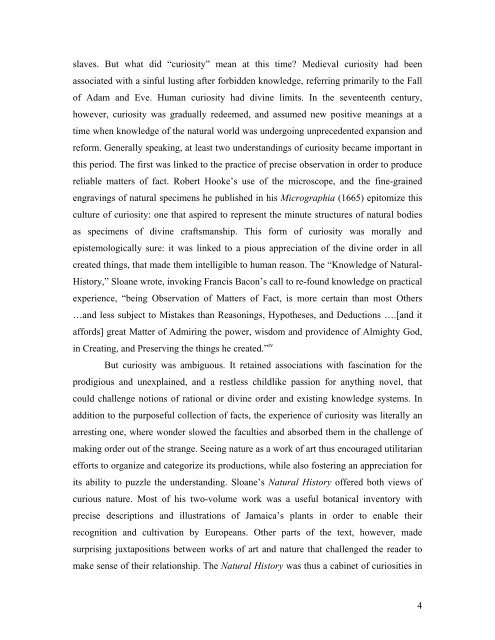Slavery in the Cabinet of Curiosities: Hans ... - British Museum
Slavery in the Cabinet of Curiosities: Hans ... - British Museum
Slavery in the Cabinet of Curiosities: Hans ... - British Museum
Create successful ePaper yourself
Turn your PDF publications into a flip-book with our unique Google optimized e-Paper software.
slaves. But what did “curiosity” mean at this time? Medieval curiosity had been<br />
associated with a s<strong>in</strong>ful lust<strong>in</strong>g after forbidden knowledge, referr<strong>in</strong>g primarily to <strong>the</strong> Fall<br />
<strong>of</strong> Adam and Eve. Human curiosity had div<strong>in</strong>e limits. In <strong>the</strong> seventeenth century,<br />
however, curiosity was gradually redeemed, and assumed new positive mean<strong>in</strong>gs at a<br />
time when knowledge <strong>of</strong> <strong>the</strong> natural world was undergo<strong>in</strong>g unprecedented expansion and<br />
reform. Generally speak<strong>in</strong>g, at least two understand<strong>in</strong>gs <strong>of</strong> curiosity became important <strong>in</strong><br />
this period. The first was l<strong>in</strong>ked to <strong>the</strong> practice <strong>of</strong> precise observation <strong>in</strong> order to produce<br />
reliable matters <strong>of</strong> fact. Robert Hooke’s use <strong>of</strong> <strong>the</strong> microscope, and <strong>the</strong> f<strong>in</strong>e-gra<strong>in</strong>ed<br />
engrav<strong>in</strong>gs <strong>of</strong> natural specimens he published <strong>in</strong> his Micrographia (1665) epitomize this<br />
culture <strong>of</strong> curiosity: one that aspired to represent <strong>the</strong> m<strong>in</strong>ute structures <strong>of</strong> natural bodies<br />
as specimens <strong>of</strong> div<strong>in</strong>e craftsmanship. This form <strong>of</strong> curiosity was morally and<br />
epistemologically sure: it was l<strong>in</strong>ked to a pious appreciation <strong>of</strong> <strong>the</strong> div<strong>in</strong>e order <strong>in</strong> all<br />
created th<strong>in</strong>gs, that made <strong>the</strong>m <strong>in</strong>telligible to human reason. The “Knowledge <strong>of</strong> Natural-<br />
History,” Sloane wrote, <strong>in</strong>vok<strong>in</strong>g Francis Bacon’s call to re-found knowledge on practical<br />
experience, “be<strong>in</strong>g Observation <strong>of</strong> Matters <strong>of</strong> Fact, is more certa<strong>in</strong> than most O<strong>the</strong>rs<br />
…and less subject to Mistakes than Reason<strong>in</strong>gs, Hypo<strong>the</strong>ses, and Deductions ….[and it<br />
affords] great Matter <strong>of</strong> Admir<strong>in</strong>g <strong>the</strong> power, wisdom and providence <strong>of</strong> Almighty God,<br />
<strong>in</strong> Creat<strong>in</strong>g, and Preserv<strong>in</strong>g <strong>the</strong> th<strong>in</strong>gs he created.” iv<br />
But curiosity was ambiguous. It reta<strong>in</strong>ed associations with fasc<strong>in</strong>ation for <strong>the</strong><br />
prodigious and unexpla<strong>in</strong>ed, and a restless childlike passion for anyth<strong>in</strong>g novel, that<br />
could challenge notions <strong>of</strong> rational or div<strong>in</strong>e order and exist<strong>in</strong>g knowledge systems. In<br />
addition to <strong>the</strong> purposeful collection <strong>of</strong> facts, <strong>the</strong> experience <strong>of</strong> curiosity was literally an<br />
arrest<strong>in</strong>g one, where wonder slowed <strong>the</strong> faculties and absorbed <strong>the</strong>m <strong>in</strong> <strong>the</strong> challenge <strong>of</strong><br />
mak<strong>in</strong>g order out <strong>of</strong> <strong>the</strong> strange. See<strong>in</strong>g nature as a work <strong>of</strong> art thus encouraged utilitarian<br />
efforts to organize and categorize its productions, while also foster<strong>in</strong>g an appreciation for<br />
its ability to puzzle <strong>the</strong> understand<strong>in</strong>g. Sloane’s Natural History <strong>of</strong>fered both views <strong>of</strong><br />
curious nature. Most <strong>of</strong> his two-volume work was a useful botanical <strong>in</strong>ventory with<br />
precise descriptions and illustrations <strong>of</strong> Jamaica’s plants <strong>in</strong> order to enable <strong>the</strong>ir<br />
recognition and cultivation by Europeans. O<strong>the</strong>r parts <strong>of</strong> <strong>the</strong> text, however, made<br />
surpris<strong>in</strong>g juxtapositions between works <strong>of</strong> art and nature that challenged <strong>the</strong> reader to<br />
make sense <strong>of</strong> <strong>the</strong>ir relationship. The Natural History was thus a cab<strong>in</strong>et <strong>of</strong> curiosities <strong>in</strong><br />
4

















